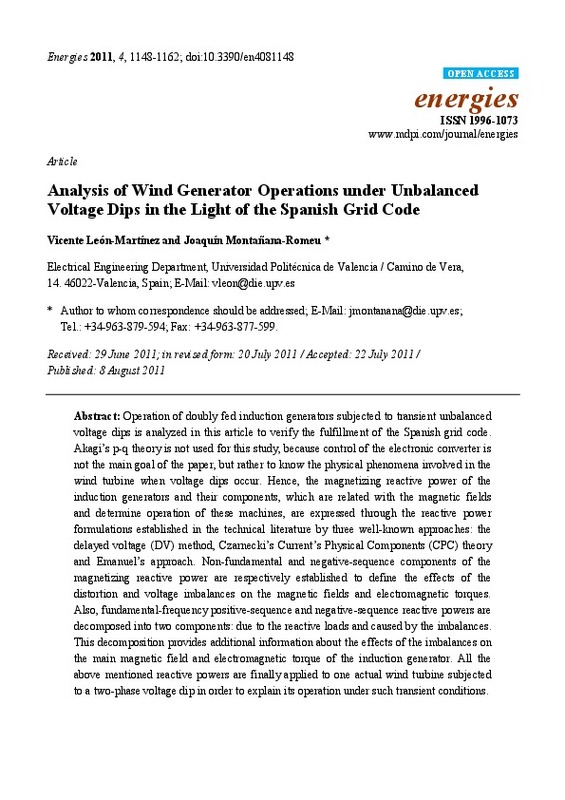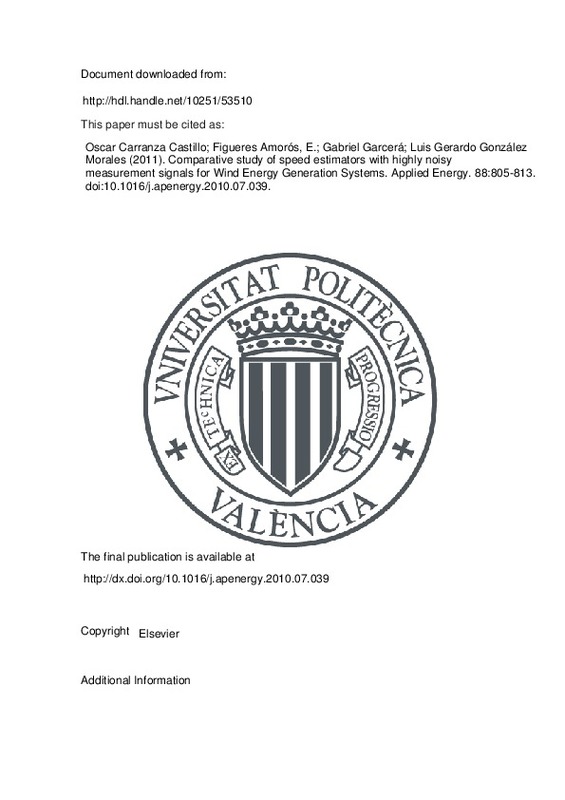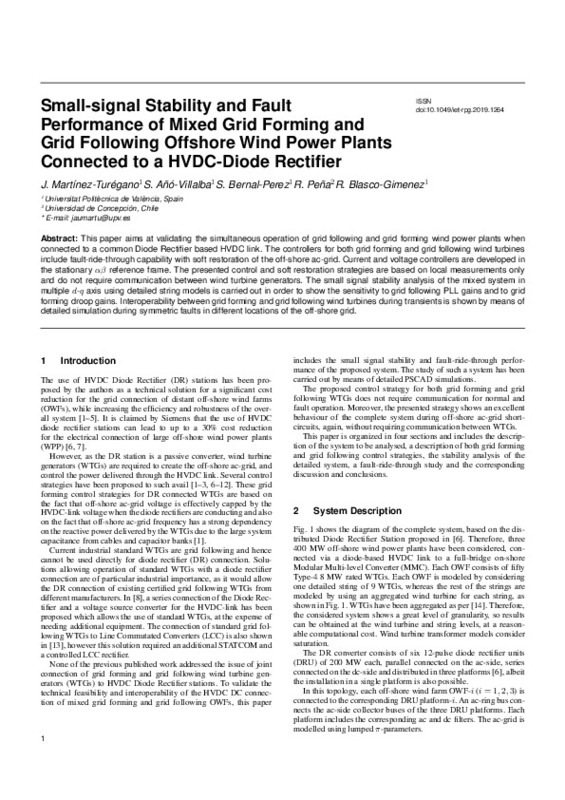JavaScript is disabled for your browser. Some features of this site may not work without it.
Buscar en RiuNet
Listar
Mi cuenta
Estadísticas
Ayuda RiuNet
Admin. UPV
Analysis of Wind Generator Operations under UnbalancedVoltage Dips in the Light of the Spanish Grid Code
Mostrar el registro sencillo del ítem
Ficheros en el ítem
| dc.contributor.author | León Martínez, Vicente
|
es_ES |
| dc.contributor.author | Montañana Romeu, Joaquín
|
es_ES |
| dc.date.accessioned | 2013-06-11T10:55:02Z | |
| dc.date.available | 2013-06-11T10:55:02Z | |
| dc.date.issued | 2011 | |
| dc.identifier.issn | 1996-1073 | |
| dc.identifier.uri | http://hdl.handle.net/10251/29627 | |
| dc.description.abstract | [EN] Operation of doubly fed induction generators subjected to transient unbalanced voltage dips is analyzed in this article to verify the fulfillment of the Spanish grid code. Akagi's p-q theory is not used for this study, because control of the electronic converter is not the main goal of the paper, but rather to know the physical phenomena involved in the wind turbine when voltage dips occur. Hence, the magnetizing reactive power of the induction generators and their components, which are related with the magnetic fields and determine operation of these machines, are expressed through the reactive power formulations established in the technical literature by three well-known approaches: the delayed voltage (DV) method, Czarnecki's Current's Physical Components (CPC) theory and Emanuel's approach. Non-fundamental and negative-sequence components of the magnetizing reactive power are respectively established to define the effects of the distortion and voltage imbalances on the magnetic fields and electromagnetic torques. Also, fundamental-frequency positive-sequence and negative-sequence reactive powers are decomposed into two components: due to the reactive loads and caused by the imbalances. This decomposition provides additional information about the effects of the imbalances on the main magnetic field and electromagnetic torque of the induction generator. All the above mentioned reactive powers are finally applied to one actual wind turbine subjected to a two-phase voltage dip in order to explain its operation under such transient conditions. © 2011 by the authors. | es_ES |
| dc.language | Inglés | es_ES |
| dc.publisher | MDPI | es_ES |
| dc.relation.ispartof | Energies | es_ES |
| dc.rights | Reconocimiento (by) | es_ES |
| dc.subject | Grid codes | es_ES |
| dc.subject | Reactive power | es_ES |
| dc.subject | Unbalanced three-phase systems | es_ES |
| dc.subject | Wind energy | es_ES |
| dc.subject | Wind power generation | es_ES |
| dc.subject | Current's physical components | es_ES |
| dc.subject | Doubly fed induction generators | es_ES |
| dc.subject | Electromagnetic torques | es_ES |
| dc.subject | Electronic converters | es_ES |
| dc.subject | Induction generator | es_ES |
| dc.subject | Main magnetic fields | es_ES |
| dc.subject | P-q theory | es_ES |
| dc.subject | Physical phenomena | es_ES |
| dc.subject | Reactive loads | es_ES |
| dc.subject | Technical literature | es_ES |
| dc.subject | Transient conditions | es_ES |
| dc.subject | Two-component | es_ES |
| dc.subject | Unbalanced three-phase system | es_ES |
| dc.subject | Unbalanced voltages | es_ES |
| dc.subject | Voltage dip | es_ES |
| dc.subject | Voltage imbalance | es_ES |
| dc.subject | Wind generators | es_ES |
| dc.subject | Asynchronous generators | es_ES |
| dc.subject | Electric power generation | es_ES |
| dc.subject | Electric utilities | es_ES |
| dc.subject | Electromagnetic field effects | es_ES |
| dc.subject | Electromagnetism | es_ES |
| dc.subject | Magnetic fields | es_ES |
| dc.subject | Wind power | es_ES |
| dc.subject | Wind turbines | es_ES |
| dc.subject | Power quality | es_ES |
| dc.subject.classification | INGENIERIA ELECTRICA | es_ES |
| dc.title | Analysis of Wind Generator Operations under UnbalancedVoltage Dips in the Light of the Spanish Grid Code | es_ES |
| dc.type | Artículo | es_ES |
| dc.identifier.doi | 10.3390/en4081148 | |
| dc.rights.accessRights | Abierto | es_ES |
| dc.contributor.affiliation | Universitat Politècnica de València. Departamento de Ingeniería Eléctrica - Departament d'Enginyeria Elèctrica | es_ES |
| dc.description.bibliographicCitation | León Martínez, V.; Montañana Romeu, J. (2011). Analysis of Wind Generator Operations under UnbalancedVoltage Dips in the Light of the Spanish Grid Code. Energies. 4(8):1148-1162. doi:10.3390/en4081148 | es_ES |
| dc.description.accrualMethod | S | es_ES |
| dc.relation.publisherversion | http://www.mdpi.com/1996-1073/4/8/1148/pdf | |
| dc.description.upvformatpinicio | 1148 | es_ES |
| dc.description.upvformatpfin | 1162 | es_ES |
| dc.type.version | info:eu-repo/semantics/publishedVersion | es_ES |
| dc.description.volume | 4 | es_ES |
| dc.description.issue | 8 | es_ES |
| dc.relation.senia | 193829 | |
| dc.description.references | Emanuel, A. E. (1999). Apparent power definitions for three-phase systems. IEEE Transactions on Power Delivery, 14(3), 767-772. doi:10.1109/61.772313 | es_ES |
| dc.description.references | Active and Reactive Power Formulations for Grid Code Requirements Verificationhttp://www.intechopen.com/articles/show/title/active-and-reactive-power-formulations-for-grid-code-requirements-verification | es_ES |
| dc.description.references | Akagi, H., Kanazawa, Y., & Nabae, A. (1984). Instantaneous Reactive Power Compensators Comprising Switching Devices without Energy Storage Components. IEEE Transactions on Industry Applications, IA-20(3), 625-630. doi:10.1109/tia.1984.4504460 | es_ES |
| dc.description.references | Hyosung Kim, Blaabjerg, F., & Bak-Jensen, B. (2002). Spectral analysis of instantaneous powers in single-phase and three-phase systems with use of p-q-r theory. IEEE Transactions on Power Electronics, 17(5), 711-720. doi:10.1109/tpel.2002.802188 | es_ES |
| dc.description.references | Czarnecki, L. (2003). Comparison of instantaneous reactive power p–q theory with theory of the current’s physical components. Electrical Engineering, 85(1), 21-28. doi:10.1007/s00202-002-0137-3 | es_ES |
| dc.description.references | Czarnecki, L. S. (2004). On Some Misinterpretations of the Instantaneous Reactive Power<tex>$phbox-q$</tex>Theory. IEEE Transactions on Power Electronics, 19(3), 828-836. doi:10.1109/tpel.2004.826500 | es_ES |
| dc.description.references | Salles, M. B. C., Hameyer, K., Cardoso, J. R., Grilo, A. P., & Rahmann, C. (2010). Crowbar System in Doubly Fed Induction Wind Generators. Energies, 3(4), 738-753. doi:10.3390/en3040738 | es_ES |











